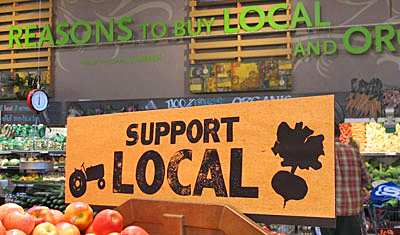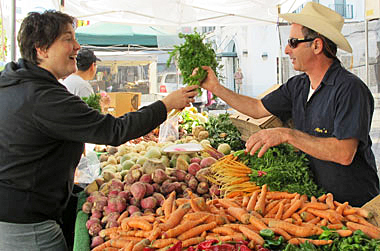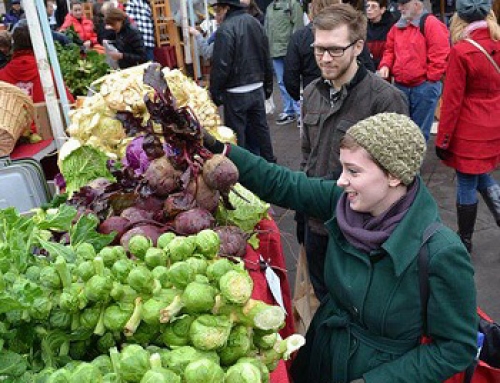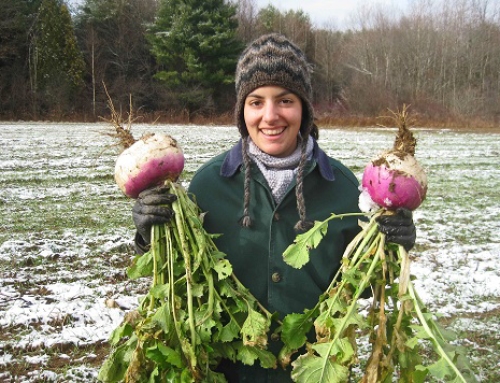 Interesting Venn overlap, don’t you think? Seasonal-sustainable meets supermarket in an organic, little “o”, kind of way. Whole Foods Markets have stepped up their source local campaign, with LA-area stores bringing in SoCal crops from such growers as Alex Weiser, longtime farmer-vendor at certified farmers markets (CFMs). Now, they’ve brought in my book as a how-to on cooking in season!
Interesting Venn overlap, don’t you think? Seasonal-sustainable meets supermarket in an organic, little “o”, kind of way. Whole Foods Markets have stepped up their source local campaign, with LA-area stores bringing in SoCal crops from such growers as Alex Weiser, longtime farmer-vendor at certified farmers markets (CFMs). Now, they’ve brought in my book as a how-to on cooking in season!
Alex and I have started a series of fall produce/holiday entertaining show-and-tells at all the Santa Monica and Venice stores. I’m glad more small farms can expand their market reach and thrilled to have more opportunities to encourage shoppers and store personnel to expand the number of foods they notice at a market…any market.
Farmer-store partnerships like Alex’s with WFM are an intriguing circling back to an older system. The California Certified Farmers’ Market Program was created in 1978 to help struggling farms survive by allowing them to bypass the grower-wholesaler-distributor chain and sell directly to consumers. Over the years, CFMs have helped mostly small operations like Weiser’s build more financially robust businesses so they now can afford to participate in the grocery store model.
Is this a good thing? For the farmer, the new-old foodway offers volume sales with two big differences from past models. Instead of the farmers having no say, it’s now closer to a free-market system where buyer and seller reach an agreed price. And the grower is no longer an anonymous supplier, which yields broader exposure and increased opportunities for customers to “know their farmer.” For shoppers, local distribution systems done right potentially shorten the time between harvest and market, giving more immediate access to better, fresher food.
But, a well-stocked grocery store does not a CFM make. If you want the interesting stuff a farmer grows just one or two rows of, or produce that has had the most careful oversight using the fewest sets of hands, you’re going to have to head to your local farmers’ market. What you can get at a forward-thinking store are fresher, tastier versions of a grower’s volume crops than you would find at indifferent markets. Interestingly, this is essentially what California’s certified farmers’ markets first offered when they came into being thirty-three years ago.
When I look at food systems, I ask myself, what’s the ultimate goal? For everyone to shop at CFMs, which today still accounts for only a teeny, but vocal, percentage of our food sourcing? Or, to make clean, fair food more accessible to more people, create opportunities for local growers and support local economies, raise the quality of supermarket produce (yes, even high-end markets can do better), and increase awareness about how and by whom our food is produced? I say, bring it all on—more excellent farmers’ markets in more places to inspire better, healthier food in stores and heightened shopper awareness. Agree or disagree?







Amelia, I’ll try to see you on Montana on Sunday. Will uou have your books? I can get some then. cheers!
Absolutely will have books there and lots of holiday entertaining ideas! Looking forward to seeing you there!
You should have a Facebook ‘like’ button on here, I think. If you had a fan page you’d build up quite a supporter base with posts like these.
Hi Julie,
Thanks for writing! I was at Wilshire and 23rd WFM this past Saturday. Alex and I will be at more SM and Venice locations first weekend of December. check out dates and times in Appearances page on my site and also upcoming events in blog sidebar. Looking forward to helping you with holiday gift giving and exploring possibilities!
Amelia, when will you be at the Whole Foods at the corner of 22nd and Wilshire? I might want to pick up a few of the books for Christmas presents and have you sign them. I’m now curating the Inner Ecology section of ecology.com. Check it out. Maybe we can do something with/or about you in the Be Nourished section. I wrote the Running Wild piece in Into Action section.
Julie Janney